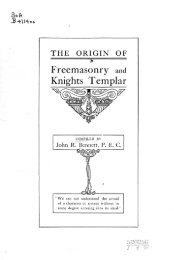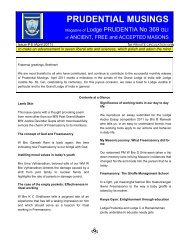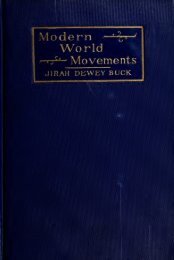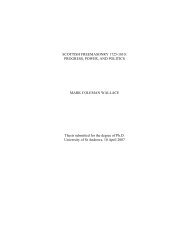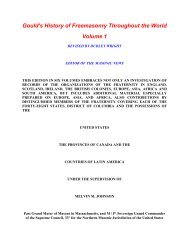illustrations of masonry by william preston - Lodge Prudentia
illustrations of masonry by william preston - Lodge Prudentia
illustrations of masonry by william preston - Lodge Prudentia
Create successful ePaper yourself
Turn your PDF publications into a flip-book with our unique Google optimized e-Paper software.
Illustrations <strong>of</strong> Masonry – <strong>by</strong> William Prestonthem, or see them wronged, but apprise them <strong>of</strong> approaching danger, and view theirinterest as inseparable from your own.Such is the nature <strong>of</strong> your engagements as a Craftsman; and these duties you are nowbound to observe <strong>by</strong> the most sacred ties.]THE SECOND SECTION.The Second Section <strong>of</strong> this Degree presents an ample field for the man <strong>of</strong> genius toperambulate. It cursorily specifies the particular classes <strong>of</strong> the Order, and explains therequisite qualifications for preferment in each. In the explanation <strong>of</strong> our usages, manyremarks are introduced, which are equally useful to the experienced artist and the sagemoralist. The various operations <strong>of</strong> the mind are demonstrated, as far as they will admit <strong>of</strong>elucidation, and a fund <strong>of</strong> extensive science is explored throughout. Here we findemployment for leisure hours; trace science from its original source; and, <strong>by</strong> drawing theattention to the sum <strong>of</strong> perfection, contemplate with admiration the wonderful works <strong>of</strong> theCreator. Geometry is displayed, with all its powers and properties; and in the disquisition<strong>of</strong> this science, the mind is filled with rapture and delight. Such is the latitude <strong>of</strong> thisSection, that the most judicious may fail in an attempt to explain it; the rational powersbeing exerted to their utmost stretch in illustrating the beauties <strong>of</strong> nature, anddemonstrating the more important truths <strong>of</strong> morality.As the orders <strong>of</strong> architecture come under consideration in this Section, the following briefdescription <strong>of</strong> them may not be improper:By order, in architecture, is meant a system <strong>of</strong> the members, proportions, and ornaments <strong>of</strong>columns and pilasters; or, it is a regular arrangement <strong>of</strong> the projecting parts <strong>of</strong> a building,which, united with those <strong>of</strong> a column, form a beautiful, perfect, and complete whole. Orderin architecture may be traced from the first formation <strong>of</strong> society. When the rigour <strong>of</strong>seasons obliged men to contrive shelter from the inclemency <strong>of</strong> the weather, we learn thatthey first planted trees on end, and then laid others across, to support a covering. The bandswhich connected those trees at top and bottom, are said to have suggested the idea <strong>of</strong> thebase and capital <strong>of</strong> pillars; and from this simple hint originally proceeded the moreimproved art <strong>of</strong> architecture.The five orders are thus classed: the Tuscan, Doric, Ionic, Corinthian, and Composite.The Tuscan is the most simple and solid <strong>of</strong> the five orders. It was invented in Tuscany,whence it derives its name. Its column is seven diameters high; and its capital, base, andentablature, have but few mouldings. The simplicity <strong>of</strong> the construction <strong>of</strong> this columnrenders it eligible where solidity is the chief object, and where ornament would besuperfluous.The Doric order, which is plain and natural, is the most ancient, and was invented <strong>by</strong> theGreeks. Its column is eight diameters high, and it has seldom any ornaments on base orcapital, except mouldings; though the frieze is distinguished <strong>by</strong> triglyphs and metopes, andthe triglyphs compose the ornaments <strong>of</strong> the frieze. The solid composition <strong>of</strong> this ordergives it a preference in structures where strength and a noble but rough simplicity arechiefly required.Page 40 <strong>of</strong> 248




